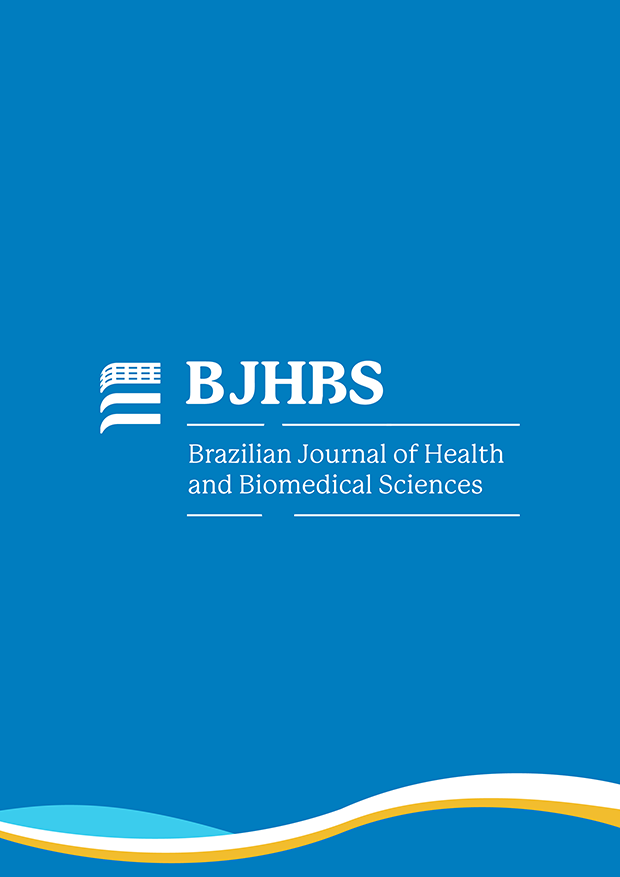Published 2022-01-03
Keywords
- Whole body vibration (WBV),
- Stroke,
- Flexibility
How to Cite
Copyright (c) 2021 Brazilian Journal of Health and Biomedical Sciences

This work is licensed under a Creative Commons Attribution-NonCommercial-NoDerivatives 4.0 International License.
Abstract
Background: The motor consequences of a stroke are mainly treated with physiotherapy and blood thinning drugs. In exercise therapy with whole body vibration, studies with other patient groups show positive effects already after a single application. In stroke patients, the effectiveness of whole body vibration is still quite inconsistent. Therefore, the present study aims to investigate the effectiveness of whole body vibration on flexibility in stroke patients. Hypothesis: Whole body vibration has a positive effect on flexibility in stroke patients. Methods: 13 stroke patients (age 68.23 ± 8.93 years, mean time past since stroke 10.82 ± 8.83 months) were randomized in two groups subjected to whole body vibration at 6 and 12 Hz, respectively. Before and after the treatment of 5 x 60 seconds with a break of 60 seconds between each set, the Sit and Reach test was performed (3 runs each, the respective mean value was evaluated). Results: Both groups improved their performance highly significantly from pre- to posttest (F(1,11) = 9.05; p = 0.01). There is no difference between groups and no interaction effect for factor time*group. Conclusions: Even lower application frequencies (6 and 12 Hz) can have a positive effect on the flexibility of stroke patients. Neverthe-less, further studies must try to develop an optimal training protocol for this patient group.
Metrics
References
- Sacco RL, Kasner SE, Broderick JP, et al. An updated definition of stroke for the 21st century: A statement for healthcare professionals from the American heart association/American stroke association. Stroke. 2013;44(7):2064–89.
- Lee G, Song C, Lee Y, et al. Effects of motor imagery training on gait ability of patients with chronic stroke. J Phys Ther Sci. 2011;23(2):197–200.
- Park YJ, Park SW, Lee HS. Comparison of the Effectiveness of Whole Body Vibration in Stroke Patients: A Meta-Analysis. Biomed Res Int. 2018; doi: 10.1155/2018/5083634.
- Lu J, Xu G, Wang Y. Effects of whole body vibration training on people with chronic stroke: a systematic review and meta-analysis. Top Stroke Rehabil. 2015;22(3):161-8. Doi: 10.1179/1074935714Z.0000000005.
- Albasini A, Krause M. Indications and contraindications in the clinical application of WBV. Immediate and long-term effects and their influence on the selection of dosage. In: Albasini A, Krause M, Rembitzki I (eds) Using Whole Body Vibration in Physical Therapy and Sport. Clinical practice and treatment exercises. London: Churchill Livingstone; 2009. pp. 65-92.
- Runge M. Die Vibrationsbehandlung – neue Wege in Therapie und Training von Muskelfunktionen. Bewegungstherapie und Gesundheitssport. 2006;22(2):70–4.
- Hanif H, Orooj M, Parveen A. Effect of whole-body vibration after a resistance exercise bout on heart rate variability in hypertensive population. J Complement Integr Med. 2021 May 17. Doi: 10.1515/jcim-2021-0064.
- Chan KS, Liu CW, Chen TW, et al. Effects of a single session of whole body vibration on ankle plantarflexion spasticity and gait performance in patients with chronic stroke: a randomized controlled trial. Clin Rehabil. 2012;26(12):1087–95. Doi: 10.1177/0269215512446314.
- Tamini S, De Micheli R, Tringali G, et al. Acute Effects of Whole-Body Vibration Exercises at 2 Different Frequencies Versus an Aerobic Exercise on Some Cardiovascular, Neuromotor and Musculoskeletal Parameters in Adult Patients With Obesity. Dose Response. 2020;18(4):1559325820965005. Doi: 10.1177/1559325820965005.
- Wuestefeld A, Fuermaier AB, Bernardo-Filho M, et al. Towards reporting guidelines of research using whole-body vibration as training or treatment regimen in human subjects—A Delphi consensus study. PloS one. 2020;15(7):e0235905. Doi: 10.1371/journal.pone.0235905.
- Rikli RE, Jones CJ. Senior Fitness Test manual. 2nd ed. Champaign: Human Kinetics; 2013.
- Griffin MJ. Handbook of Human Vibration. London: Elsevier; 1990.
- Kaeding TS. Vibrationstraining. Ein praxisorientiertes Handbuch. Schorndorf: Hofmann; 2016.
- Abercromby AFJ, Amonette WE, Layne CS, et al. Vibration Exposure and Biodynamic Responses during Whole-Body Vibration Training. Med Sci Spo Ex. 2007;39(10):1794–1800.
- Cardinale M, Pope MH: The effects of whole body vibration on humans: Dangerous or advantageous? Acta Physiol Hung. 2003;90(3):195–206.
- Dupuis H, Jansen G. Immediate effects of vibration transmitted to the hand. In: Bianchi G, Frolov KV, Oledzki A (eds) Man under vibration. Suffering and protection. Amsterdam: Elsevier; 1981. pp 76–86.
- Wakeling JM, Nigg BM, Rozitis AI. Muscle activity damps the soft tissue resonance that occurs in response to pulsed and continuous vibrations. J Appl Physiol. 2002;93(3):1093–1103.
- Vujnovich AL, Dawson NJ. The Effect of Therapeutic Muscle Stretch on Neural Processing. JOSPT. 1994;20(3):145-153.
- Schönthaler SR, Ohlendorf K, Ott H, et al. Biomechanische und neurophysiologische Parameter zur Erfassung der Dehnbarkeit von Muskel-Sehnen-Einheiten. Dtsch Z Sportmed. 1998;49:223-230.
- Scott AB. Change of eye muscle sarcomers according to eye position. J Ped Ophth Strab. 1994;31(4):85-88.





